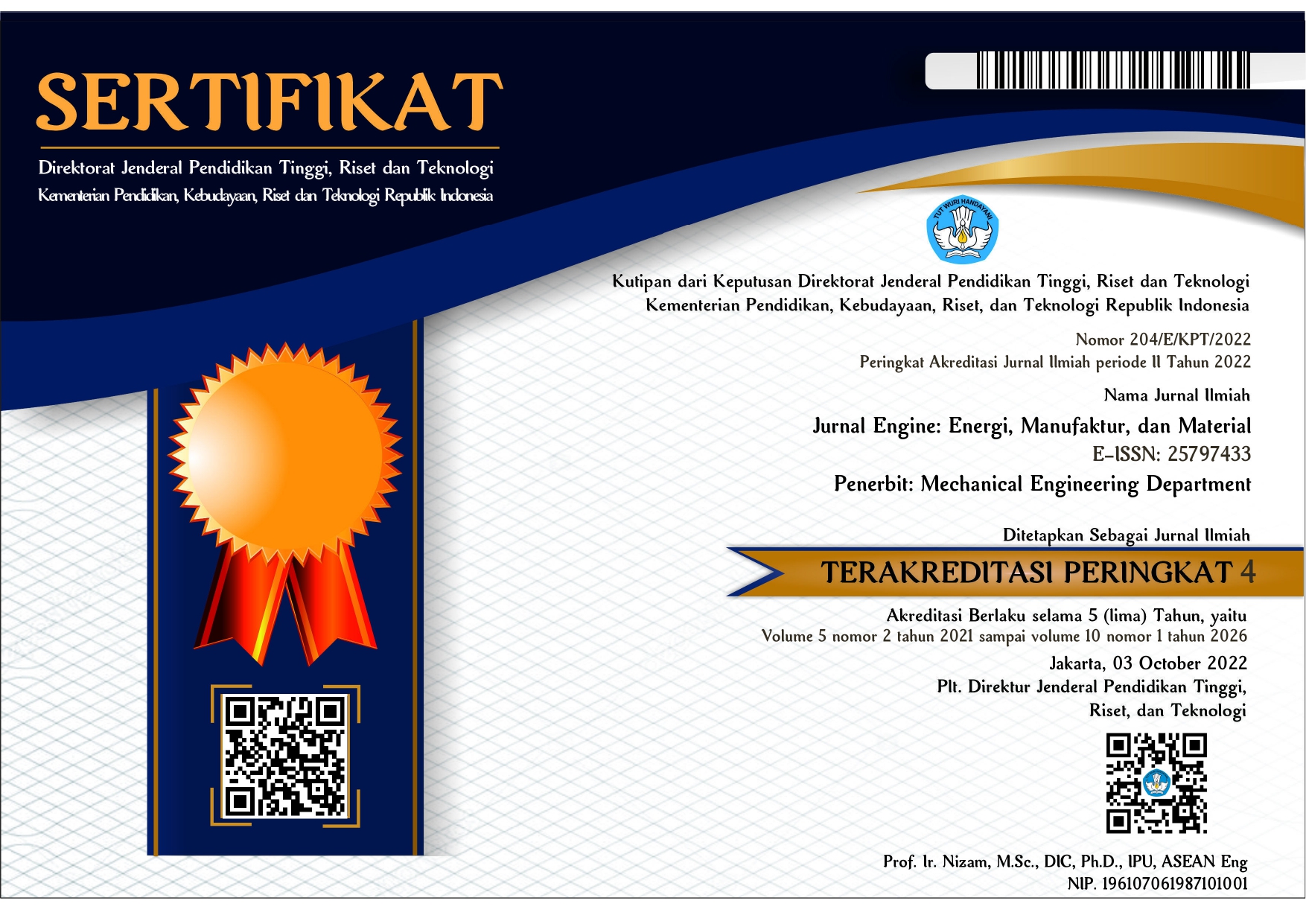Analisis Sifat Mekanik dan Sifat Termal Komposit Poliuretan Berpenguat Serat Nanas Dan Cangkang Kemiri
(1) Politeknik STMI Jakarta
(2) Politeknik STMI Jakarta
(3)
(*) Corresponding Author
Abstract
The development of materials that have good durability continues to grow rapidly. One way to increase the durability of a material is the manufacture of composite materials. Composite is a material consisting of a matrix and a reinforcing material. The purpose of this study is first to determine the best composition for fillers and matrix in the manufacture of polyurethane composites reinforced with pineapple fiber and candlenut shells, second to determine the mechanical properties of the composite material, and third to determine the thermal stability of the composite material. To find out the best composition results, tensile strength tests were carried out using the Universal Testing Machine (UTM) and thermal properties were tested using Differential Scanning Calorimetry (DSC) and Thermogravimetric Analysis (TGA). In this study, variations in the composition of composite materials from polyurethane, pineapple fiber, candlenut shell powder and aluminum powder will be carried out with the percentages of filler and matrix of 50:50, 60:40 and 70:30 (%). Based on the results of the study, the composite with a variation of 50:50(%) has the best mechanical properties with a tensile strength 10,592 MPa, strain value (elongation at break) 0.7072% and modulus of elasticity (E) 5526,054 MPa. Stability termal of composite was found that the composition with the ratio of filler and matrix 60:40 (%) is the best composition based on the thermal properties. It has a melting temperature 287.4℃ and begins to decompose at temperature 292.65℃.
Keywords
Full Text:
PDFReferences
Akovali, G. (2001). Handbook of composite fabrication. iSmithers Rapra Publishing.
Aminur, A., Hasbi, M., & Gunawan, Y. (2015). Proses Pembuatan Biokomposit Polimer Serat Untuk Aplikasi Kampas Rem. Prosiding Semnastek.
Barczewski, M., Kurańska, M., & Testing, K. S.-P. (2020). Rigid polyurethane foams modified with thermoset polyester-glass fiber composite waste. Polymer Testing, 81, 106190.
Borowicz, M., Paciorek-Sadowska, J., Lubczak, J., Czupry´nski, B., & Czupry´nski, C. (2019). Biodegradable, flame-retardant, and bio-based rigid polyurethane/polyisocyanurate foams for thermal insulation application. Polymers, 11(11), 1816.
Członka, S., Strąkowska, A., Strzelec, K., Kairytė, A., & Kremensas, A. (2020). Bio-based polyurethane composite foams with improved mechanical, thermal, and antibacterial properties. Materials, 13(5), 1108.
Daulay, S., USU, F. W.-J. T. K., & 2014, U. (2014). Pengaruh Ukuran Partikel dan Komposisi Terhadap Sifat Kekuatan Bentur Komposit Epoksi Berpengisi Serat Daun Nanas. Jurnal Teknik Kimia USU, 3(3), 13–17.
Dwiyati, S., Kholil, A., & Dan, F. W. (2017). Pengaruh penambahan karbon pada karakteristik kampas rem komposit serbuk kayu. Jurnal Konversi Energi Dan Manufaktur, 4(2), 108–114.
Fahmi, H., & Hermansyah, H. (2011). Pengaruh orientasi serat pada komposit resin polyester/serat daun nenas terhadap kekuatan tarik. Jurnal Teknik Mesin, 1(1), 46–52.
Hidayat, P. (2008). Teknologi pemanfaatan serat daun nanas sebagai alternatif bahan baku tekstil. Teknoin, 13(2), 31–35.
Nugraha, P. (2007). Teknologi Beton; Dari Material, Pembuatan, Ke Beton Kinerja Tinggi.
Rahmatul‘Ula, I., Masturi, M., & Yulianti, I. (2015). Analisis Keausan Kampas Rem Non Asbes Berbahan Limbah Organik Kulit Tempurung Kemiri. Jurnal Fisika Unnes, 5(1), 79482.
Rizkiansyah, R. R., & Mardiyati, S. (2017). Pengaruh Berat Molekul Terhadap Ketahanan Termal, Absorpsi Air dan Kemampuan Biodegradasi Plastik Selulosa Teregenerasi dari Kapas Limbah Industri Tekstil. Prosiding Seminar Nasional Metalurgi Dan Material (SENAMM), 16–28.
Wang, H., Xu, J., Du, X., Du, Z., Cheng, X., & Wang, H. (2021). A self-healing polyurethane-based composite coating with high strength and anti-corrosion properties for metal protection. Composites Part B: Engineering, 225, 109273.
Warman, W., Darmadi, H., Abdillah, A., & Safitri, S. (2019). Pengembangan Bahan Kampas Rem Tromol (Drum Brake Pad) Sepeda Motor Berbahan Dasar Komposit Cangkang dan Serat Buah Kelapa Sawit Dengan Poliuretan Sebagai Pengikat. Ready Star, 2(1), 122–129.
Yovial, Y., Marthiana, W., & Duskiardi, D. (2017). Pemanfaatan Cangkang Kemiri Dengan Ukuran Serbuk D< 250 µm Sebagai Bahan Penguat Pada Komposit Resin Epoksi. Jurnal Agroindustri, 7(1).
DOI: https://doi.org/10.30588/jeemm.v6i2.1038
Article Metrics
Abstract view : 442 timesPDF - 15 times
Refbacks
- There are currently no refbacks.
Copyright (c) 2022 Silvia Silvia, Rochmi Widjajanti, Ida Nur Apriani

This work is licensed under a Creative Commons Attribution 4.0 International License.

Jurnal Engine: Energi, Manufaktur, dan Material is licensed under a Creative Commons Attribution 4.0 International License.




.jpg)


















